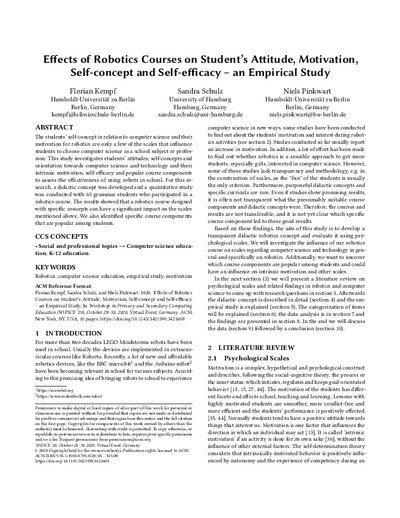Effects of robotics courses on student's attitude, motivation, self-concept and self-efficacyan empirical study
Publikationsdatum:
Zu finden in: WiPSCE '20, 2020
|
 |
 Diese Seite wurde seit 2 Jahren inhaltlich nicht mehr aktualisiert.
Unter Umständen ist sie nicht mehr aktuell.
Diese Seite wurde seit 2 Jahren inhaltlich nicht mehr aktualisiert.
Unter Umständen ist sie nicht mehr aktuell.
 Zusammenfassungen
Zusammenfassungen

The students' self-concept in relation to computer science and their motivation for robotics are only a few of the scales that influence students to choose computer science as a school subject or profession. This study investigates students' attitudes, self-concepts and orientation towards computer science and technology and their intrinsic motivation, self-efficacy and popular course components to assess the effectiveness of using robots in school. For this research, a didactic concept was developed and a quantitative study was conducted with 63 grammar students who participated in a robotics course. The results showed that a robotics course designed with specific concepts can have a significant impact on the scales mentioned above. We also identified specific course components that are popular among students.
 Dieses Konferenz-Paper erwähnt ...
Dieses Konferenz-Paper erwähnt ...
 Personen KB IB clear | Michal Armoni , Mordechai Ben-Ari , Gert Braune , Philipp Brauner , Torsten Brinda , Jacob Cohen , Timo Göttel , Ludger Humbert , Fatima Kaloti-Hallak , Maria Knobelsdorf , Thiemo Leonhardt , Andreas Mühling , Niels Pinkwart , Ulrik Schroeder , Carsten Schulte , Sandra Schulz , Scarlet Schwiderski-Grosche , Stefan Schwinem , Sue Sentance , David Tobinski , Bernd Weidenmann , Martina Ziefle | ||||||||||||||||||||||||||||||||||||||||||||||||||||||||||||||||||||||||||||||||||||||||||
 Begriffe KB IB clear | Educational RoboterEducational Roboter
, Informatikcomputer science
,  Motivation Motivation motivation
, motivation
,  Roboter Roboter robot
, robot
,  Schule Schule school
, Selbstwirksamkeitself efficacy school
, Selbstwirksamkeitself efficacy
| ||||||||||||||||||||||||||||||||||||||||||||||||||||||||||||||||||||||||||||||||||||||||||
 Bücher | |||||||||||||||||||||||||||||||||||||||||||||||||||||||||||||||||||||||||||||||||||||||||||
 Texte |
|
 Dieses Konferenz-Paper erwähnt vermutlich nicht ...
Dieses Konferenz-Paper erwähnt vermutlich nicht ... 
 Nicht erwähnte Begriffe | Informatik-Didaktik, Informatik-Unterricht (Fachinformatik), LehrerIn, Unterricht |
 Zitationsgraph
Zitationsgraph
 Zitationsgraph (Beta-Test mit vis.js)
Zitationsgraph (Beta-Test mit vis.js)
 Zeitleiste
Zeitleiste
 1 Erwähnungen
1 Erwähnungen 
- Informatikunterricht zwischen Aktualität und Zeitlosigkeit - 20. GI-Fachtagung Informatik und Schule (Lutz Hellmig, Martin Hennecke) (2023)


- Assoziationen und Kompetenzzuschreibung angehender Sachunterrichtslehrkräfte zur Informatik (Stefan Napierala, Jan Grey, Inga Gryl) (2023)


- Assoziationen und Kompetenzzuschreibung angehender Sachunterrichtslehrkräfte zur Informatik (Stefan Napierala, Jan Grey, Inga Gryl) (2023)
 Anderswo finden
Anderswo finden
 Volltext dieses Dokuments
Volltext dieses Dokuments
 |  Effects of robotics courses on student's attitude, motivation, self-concept and self-efficacy: Fulltext at the ACM Digital Library ( Effects of robotics courses on student's attitude, motivation, self-concept and self-efficacy: Fulltext at the ACM Digital Library ( : :  , 828 kByte; , 828 kByte;  : :  ) ) |
 Anderswo suchen
Anderswo suchen 
 Beat und dieses Konferenz-Paper
Beat und dieses Konferenz-Paper
Beat hat Dieses Konferenz-Paper während seiner Zeit am Institut für Medien und Schule (IMS) ins Biblionetz aufgenommen. Beat besitzt kein physisches, aber ein digitales Exemplar. Eine digitale Version ist auf dem Internet verfügbar (s.o.). Es gibt bisher nur wenige Objekte im Biblionetz, die dieses Werk zitieren.























 Biblionetz-History
Biblionetz-History